

Select each band in turn as the input for one of the four aux tracks.
Pro tools 12.6 how to mix instrument track to audio track pro#
This offers the Pro Multiband Dynamics plug-in as a choice, and within that, you’ll see options for each of the four bands: Low Band, Low-Mid Band, Mid-High Band and High Band. Add an instance of the Multiband Dynamics plug-in onto a track, then add four aux tracks with the same track format as the track with the Multiband Dynamics plug-in (Screen 3).Ĭlick on the input selector of the first aux track and you will see that as well as Interface and Buss, there is a third option labelled Plug-in. What’s less well known is that you can do a similar trick with the Pro Multiband Dynamics plug-in itself, thanks to a feature called Auxiliary Output Stems or AOS for short. Split LevelsĪvid’s Pro Multiband Dynamics comes with a separate plug-in called Pro Multiband Splitter, allowing you to split the input signal into separate frequency bands to be processed independently. You can also achieve some interesting results using a different channel’s output as the side-chain signal. This is really cool and can save a lot of time compared to riding a fader for the same effect. What this means is it only passes audio when the input signal goes above the compressor’s threshold, so you’ll only get reverb on the loudest sections of the signal. With this enabled, the compressor only outputs audio when gain-reduction is taking place. Screen 2: Enabling the loudspeaker icon in the Pro Compressor plug-in means that it only passes audio to the reverb when compression is taking place. On the Pro Compressor, I have enabled the Monitor button, visible as a small speaker icon near the top-right corner of the compression display. For example, in Screen 2 I have an Avid Pro Compressor plug-in feeding an Exponential Audio R2 reverb plug-in.

This can be a useful diagnostic tool, but it also has the potential to be used creatively. When you enable this option, you hear only the contribution that the plug-in is adding to the signal - in other words, the difference between the dry and the processed signal. There are a growing number of plug-ins that have a Monitor or ‘difference’ option. Note that this doesn’t work if you use the Grabber tool to move clips. However, Screen 1c shows what happens when I select Send To Back and then repeat the nudge: this time, the left-hand clip has gone underneath the right-hand clip. In 1b, I have nudged the left-hand clip rightwards, and it has gone over the top of the right-hand clip. Screen 1c.Screens 1a and 1b show two adjacent clips. The Clip menu offers two options named Send To Back and Bring To Front, which relate only to how clips behave when nudged. When you are working with layered content in a program such as Photoshop, there is the option to change the order of the layers, and I was interested to learn that this feature exists in Pro Tools also. In this month’s Pro Tools workshop, I am going to share a number of less well-known tricks that I have picked up along the way, beginning with an option I wasn’t aware of until very recently: Send To Back or Bring To Front. We serve up a tempting menu of little-known Pro Tools tips, including some new features in 12.6. Screens 1a-1c: You can choose whether nudged clips should cover up overlapping clips (1b), or be placed behind them (1c).


 0 kommentar(er)
0 kommentar(er)
